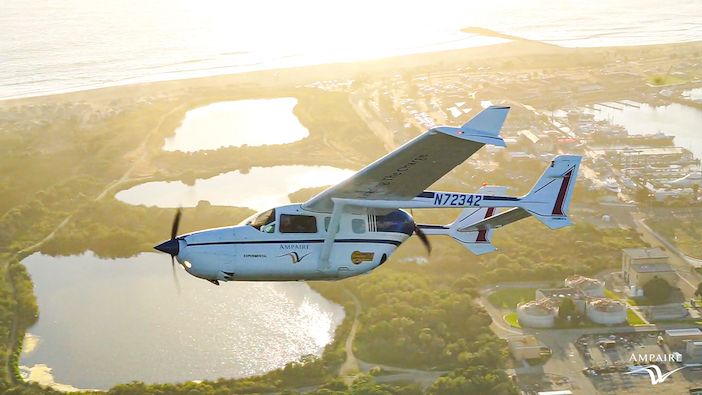Los Angeles-based Ampaire is to start testing its hybrid commercial aircraft on commercial routes in Hawaii later this year.
The company has begun a flight test program of its Electric EEL, a twin-engine Cessna 337 Skymaster modified to fly with one conventional combustion engine and one electric motor. The six-seat aircraft is the largest hybrid-electric aircraft flying today, according to Ampaire.
The aircraft, which made its first flight in June, was retrofitted with Ampaire’s proprietary electric propulsion system and is powered by a lightweight battery system. The system is a parallel hybrid, meaning the internal combustion engine and electric motor work in concert to optimize power output as the plane flies.
The Electric EEL will enter flight trials on commercial routes with Mokulele Airlines in Hawaii later this year, it was revealed last week. FAA certification of the Electric EEL is expected during 2021.
However the CEO of Ampaire, Kevin Noertker, said his company is developing retrofittable hybrid-electric kits for private and regional aircraft because such retrofits offer the most viable way to decarbonise aviation after launching the flight test program for the product.
“The most practical way to achieve an all-electric future is to jump start the market with a partially-electric present,” said Noertker. “We’re pursuing a pragmatic, step-by-step approach, a scalable plan to quickly commercialize and expand the electric airplane market. This approach recognizes that other development programs for clean-sheet all-electric aircraft will consume hundreds of millions of dollars in R&D and potentially require a decade or more to certify.
“Such programs will be complicated by the rapid evolution and improvement of electric battery and powertrain technology, and the lack of experience of regulators in the area of electric aircraft.
“In contrast, Ampaire is currently demonstrating the ability to cut fuel consumption by 50% and reduce emissions accordingly. The development cost of modifying an existing aircraft is relatively low and manageable versus a clean-sheet design.
“Both Ampaire and the FAA have an opportunity to work together to develop a regulatory framework that promotes safety and creates a predictable, manageable path for certifying electric aircraft.
“The Cessna 337 modification is a first step. The next may be a hybrid or fully electric retrofit of a nine- to 19-passenger commuter/cargo aircraft. As batteries and powertrains mature, we will shift our focus to clean-sheet designs such as our nine-passenger, zero-emissions TailwindTM concept.
“By that time, we will have established strong cash-flow from retrofit programs as well as engineering and certification expertise that will earn the confidence of investors, partners, aircraft operators, and regulators.”





